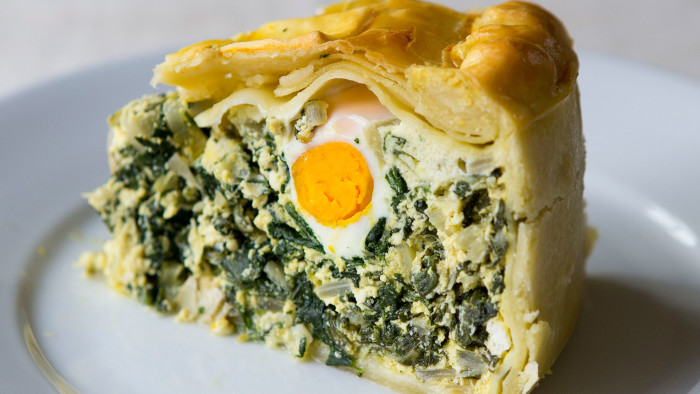Easter recipe: Torta Pasqualina

Simply sign up to the Life & Arts myFT Digest -- delivered directly to your inbox.
Torta Pasqualina
Scroll down for method and ingredients
Serves eight
Easter, so often construed in culinary terms to be about lamb, is really about eggs. We make pancakes on Shrove Tuesday to use up any eggs we have left over. Come spring and the Easter festival, the hens start laying and we are allowed to eat eggs again: whether in chocolate or in paint, in hunts or in egg fights, Easter has always been the celebration of that potent symbol of rebirth. And yet, although they are absolutely central to the idea of Easter, there are not so many dishes that feature eggs.
Enter, stage right, the Torta Pasqualina. It’s full of them, some beaten into the mixture and some cooked whole in the pie. It is the eggs that make the Torta so exceptional. It is from Genoa, the first Italian city that I ever encountered, a city that is the least attractive, the most mercantile and endowed with the poorest cultural heritage and yet has a vitality and energy that other cities sometimes lack. It was a Genovese who discovered America and probably another one who discovered a cheese and spinach pie somewhere around the Aegean and brought the idea back home, to be transformed into a classic symbol of Easter.
I had fun making this. I have to admit that it took time, probably the best part of two hours, but I am not a believer that everything should be quick and easy. It should be remembered that the pride one gets from making something is usually in direct proportion to the effort that went into it. Traditionally, this dish is made over the weekend and then taken on a picnic on Easter Monday. Which seems like a good idea to me.
Rowley Leigh is the chef at Le Café Anglais
Method
Best eaten the day it is cooked, cool but not chilled. It can certainly be prepared a day in advance.
- Remove any rind and chop the pancetta into very small cubes. Melt the butter in a heavy casserole and add the pancetta, letting it slowly render its fat. Peel the onion and chop it finely before adding it to the mix. Let it stew gently in the butter and fat until it begins to colour. Remove the skin from the sausages, chop them coarsely and then add to the onion. Mash the meat continually with a wooden spoon to break it up and seal it.
- Sieve the flour into a mixing bowl and add the salt. Either using an electric mixer with the blender attachment, a food processor or fingers, add half the olive oil and the very cold water and knead into a very strong dough that collects easily into a ball. Divide into eight small balls. Cover with a damp cloth.
- Place the ricotta in a mixing bowl and finely grate the lemon zest over it. Halve and squeeze the lemons and strain the juice into another bowl. Cut the base of the artichokes – unless the stalks are thick, in which case they should be left on and peeled – and trim carefully, removing any green from the base. Dip in the lemon juice, then trim the leaves with a sharp knife and cut off the artichoke tops. Macerate them in the lemon juice before dropping into boiling water and cooking until tender (eight to 10 minutes). Drain and leave to cool.
- Wash the chard well in cold water. Unless the stalks are very thick (when they must be cooked separately), chop them finely and drop into a large pot of salted water. Drain as soon as tender. Pick the stalks off the spinach and wash the leaves. Drop these in boiling water and as soon as they wilt, drop them in ice-cold water. Drain, squeeze out the water and chop coarsely.
- Peel and chop the onion in a couple of tablespoons of olive oil, stew gently for 10 minutes without allowing it to colour and then add the halved artichokes (removing any choke), the chard and the spinach. Season well and add the grated nutmeg. Leave to cool a little before adding to the ricotta mixture. Mix and add the grated Parmesan and three beaten eggs. Mix again and taste for seasoning.
- Brush the inside of a 23cm springform mould with olive oil. Roll out the first ball of dough until it is very thin and flexes like a piece of filo dough. Drop it into the mould, making sure there is a good 4cm overhang all the way around, brush this with more oil and repeat the process for three more balls of dough. Fill the lined mould with the mixture, then make six evenly spaced deep indentations and drop an egg into each one.
- Cover the pie with another four layers of wafer-thin dough, brushing each one as before. Cut round the perimeter with scissors so there is only 2cm of overhang. Roll this up and turn it down to make a raised border. Mix one more egg with a tablespoon of milk and brush the surface of the pie with this wash. Bake in a medium-hot oven, 190C, for 40 minutes. Make sure the centre, tested with a skewer, is very hot. Leave to cool.
Rowley’s drinking choice
Tradition says go with Vermentino, Liguria’s favourite grape. Seems as good an idea as any, but I always think a light and fruity red accompanies eggs just as well.
Comments